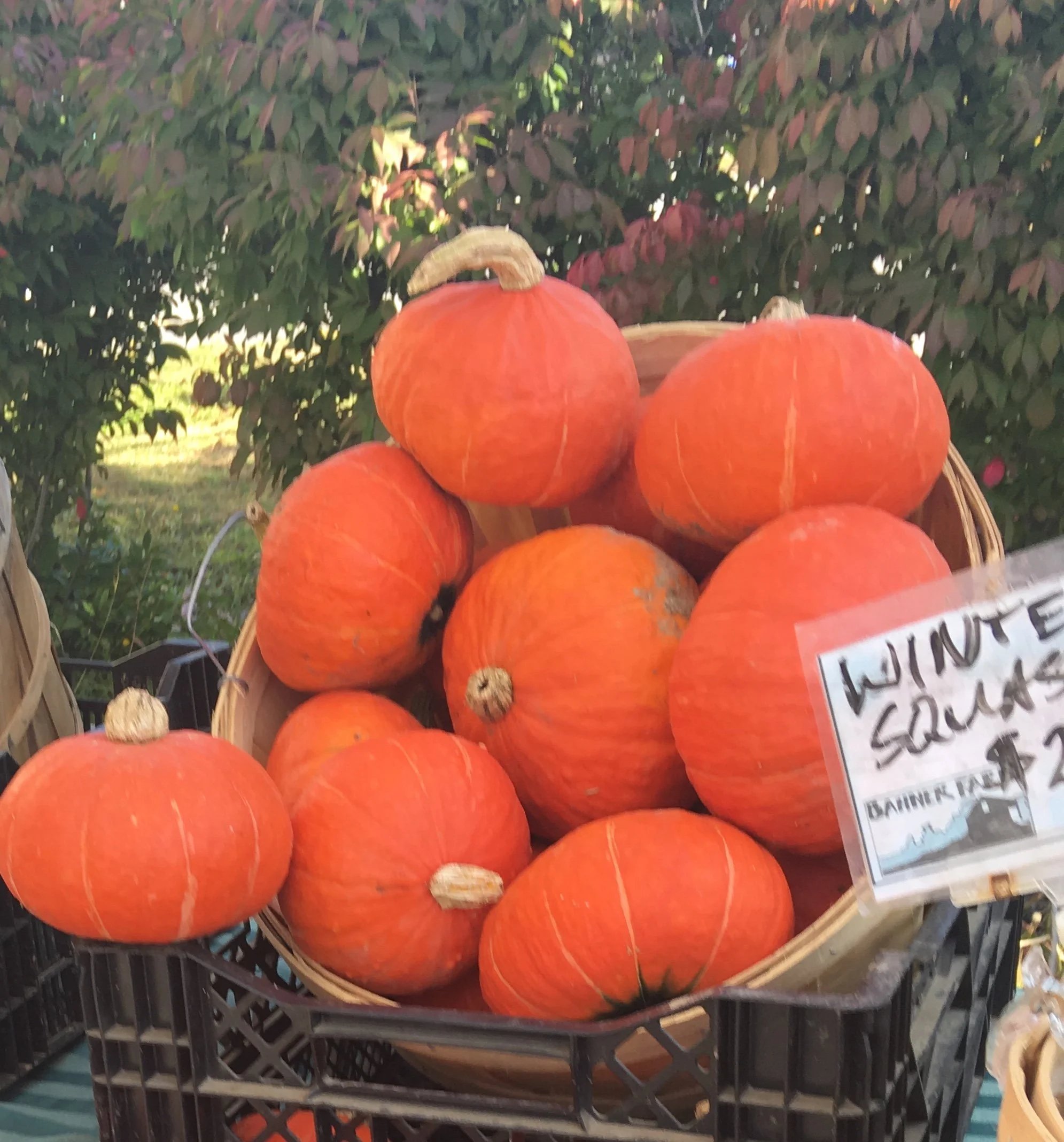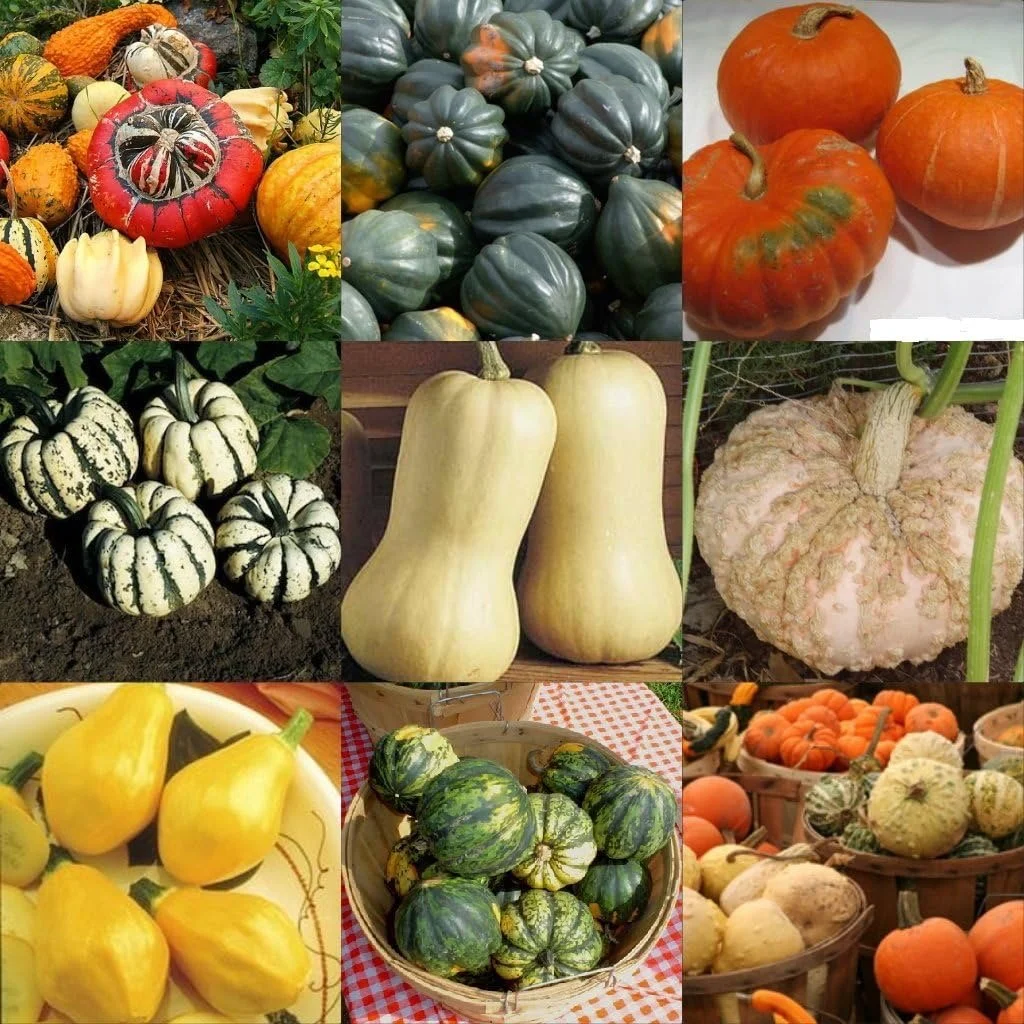Squash
Winter squash is at its peak in November and can be a tasty addition to Thanksgiving dinner.
Hard-shelled, or "winter" squash, is part of the gourd family and grown to maturity with thicker, harder skins than the soft-shelled summer squash. The flesh is a yellow or orange color that is darker than the soft-shelled varieties, with more nutrients and a higher amount of complex carbohydrates.
Winter squash vary in color, size, shape, and flavor. They can range in size from a small acorn squash, which can weigh not much more than a half-pound, to the banana squash that can weigh as much as 70 pounds. They store well and can be kept on the counter for a month or more.
Look for hard shells and squash that is heavy for its size. They're sweet, full of antioxidants, and perfect for autumn cooking.
Here are a few varieties of squash available at farmers markets:
Acorn -- Shaped like a large acorn. It has sweet, fibrous flesh and has ribs that run the length of its blackish-green or golden-yellow skin.
Butternut -- Beige colored and shaped like a vase. It has a bulbous end and pale, creamy skin, with a choice, fine-textured, deep-orange flesh with a sweet, nutty flavor. The more orange the color, the riper and sweeter the squash.
Spaghetti -- It has a golden-yellow, oval rind and a mild, nutlike flavor. When cooked, the flesh separates in strands that resemble spaghetti pasta. The more yellow the spaghetti squash, the riper and best to eat.
Kabocha -- Also known as a Ebisu or Japanese pumpkin, Kabocha refers most commonly to a squash of the buttercup type. It has a rich sweet flavor, and often dry and flaky when cooked.
Delicata -- Also called sweet potato squash, peanut squash, and Bohemian squash. It has a creamy pulp that tastes a bit like sweet potatoes.
Nutrition
Squash are an excellent source of alpha-carotene and beta-carotene, which converts to Vitamin A; vitamin C; dietary fiber; antioxidant and anti-inflammatory compounds that may reduce your risk of heart disease and certain cancers; and polysaccharides that help regulate and/or control blood sugar. Squash is also low in calories.
Selecting
Winter squash varieties that are commonly available include spaghetti, acorn, banana, Hubbard and butternut squash, but there are many more. Each type differs in shape, color, size and flavor. Look for squash with hard, tough rinds and the stem attached; free of cuts, punctures or sunken spots. The squash should be heavy for its size - that indicates there is plenty of edible flesh.
Storing and Preserving
Most varieties of squash have hard shells that are difficult to puncture and allow for a longer storage life. If uncut and free of bruises, winter squash can be stored in a cool, dry place for up to three months. The ideal spot is an airy location where they will not freeze, preferably between 50 and 55 degrees Fahrenheit.
For best results, keep air space between the squash so that they do not touch each other. Once cut open, prepare immediately or store in the refrigerator for four to five days. Cooked squash can be frozen for up to a year.
Preparing
Winter squash has a mild tasting flesh and can be prepared with sweet or savory flavors.
To prepare, thin skinned varieties can be peeled with a paring knife or vegetable peeler. Peeled pieces can be cut into cubes and roasted, steamed or boiled until tender. Use any recipe calling for cooked mashed or pureed squash.
Squash with a thicker rind may present more of a challenge to peel. Most recipes using these varieties call for washing the squash, and then cutting the squash in half lengthwise or into pieces.
Small acorn squash and spaghetti squash can be washed and pierced in several places and baked whole. Piercing is important to prevent the shell from bursting during cooking.
Baked squash can be frozen for future use. To calculate servings, one pound of the cooked flesh will serve 4.
Squash seeds are a healthy and delicious snack food and can be prepared the same way as pumpkin seeds. Wash the seeds in warm water and spread them out to dry. Toss in a little oil or spray a shallow baking sheet with oil and spread the seeds in a single layer. Bake them at 250°F for about 15-20 minutes, stirring occasionally. Salt if desired, cool and store.
Harvesting
Squash tastes best when harvested young.
Pick zucchini when it is eight inches long, and pick crookneck squash when only six inches long.
Immature winter squash lacks flavor, so wait until the rind is hard.
Harvest winter squash with two inches of stem remaining. A stem cut too short is like an open wound, and will cause early decay.


